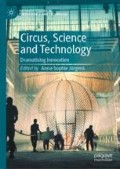Abstract
This chapter contends that circus arts rely on technological invention of apparatus to advance athletic and aesthetic innovation, and that this process then influences wider social practice. The Hanlon (Hanlon-Lees) Brothers set new limits in acrobatic action with aerial technology for their nineteenth-century circus act, subsequently developing the safety net for flying trapeze and inventing new stage machinery for pantomime in their macabre theatre. The rebound action on the safety net in circus inspired the twentieth-century invention of the trampoline by George Nissen, and trampoline and its action became a leisure activity, a new circus act and an Olympic sport. This chapter asks: What theatrical emotions intersect with these performance technologies? It finds that the Hanlon-Lees (during the 1860–1870s) and Nissen (in the 1930–1940s) undertook their early artistic activity in a society under threat of war, but that they performed divergent emotional responses to risk and fear within society. Both included nonhuman animals in the performance—in support of impressions of frightening menace and comic death in the Hanlon-Lees’ theatre, and to reassure the public with comic playfulness in Nissen’s performance.
Access this chapter
Tax calculation will be finalised at checkout
Purchases are for personal use only
References
Altidor, Welby. 2017. Practicing Creative Courage. Hoboken, NJ: Wiley.
Beck, Ulrich. 2009. World at Risk. Trans. by Ciaran Cronin. Cambridge: Polity Press.
Bourke, Joanna. 2001. The Emotions in War: Fear and the British and American Military, 1914–45. Historical Research 74 (185): 314–330.
Cosdon, Mark. 2006. ‘Serving the Purpose Amply’: The Hanlon Brothers’ Le Voyage En Suisse. Journal of American Drama and Theatre 18 (2): 71–100.
Covello, Vincent, and Gary Flamm (Eds.). 1983. The Analysis of Actual Versus Perceived Risks. Boston, MA: Springer.
Coxe, Antony Hippisley. 1980. A Seat at the Circus. Hamden, CT: Archon Books.
Darwin, Charles. 1999. The Expression of the Emotions in Man and Animals. London: Fontana Press.
de Banville, Théodore. 1995. Preface. In Mémoires et Pantomimes des Frères Hanlon Lees, by Frères Hanlon Lees (George Hanlon), 5–15. Paris: Reverchon et Vollet (n.d). Document électronique 1995.
Ekman, Paul. 1999. Afterword. In The Expression of the Emotions in Man and Animals, by Charles Darwin, 363–393. London: Fontana Press.
‘George Nissen’. https://en.wikipedia.org/wiki/George_Nissen. Accessed 10 September 2018.
Golder, Hilary, and Diane Kirkby. 2003. Mrs. Mayne and Her Boxing Kangaroo: A Married Woman Tests Her Property Rights in Colonial New South Wales. Law and History Review 21 (32): 585–605.
Gossard, Steve. 1994. A Reckless Era of Aerial Performance, the Evolution of the Trapeze. Manuscript publication, c/- Milner Library, Illinois State University.
Graves, Edward. 1945. New World’s Circus Opens Season. World’s Fair, 13 April 1945, 12.
Jackson, Stephen, and Karl Vernes. 2010. Kangaroo. Sydney: Allen and Unwin.
Jürgens, Anna-Sophie. 2014. Batman’s Joker, a neo-modern clown of Violence. Journal of Graphic Novels and Comics 5 (4): 441–454.
Jürgens, Anna-Sophie. 2019. Fun-de-siècle: Dance, Popular Spectacles and the Circus. Tanz & Archiv 8: 172–188.
Linke, Uli, and Danielle Taana Smith (Eds.). 2009. Cultures of Fear: A Critical Reader. London: Pluto Press.
Marshall, Jonathan. 2016. Performing Neurology. New York: Palgrave Macmillan.
McKinven, John A. 1998. The Hanlon Brothers. Glenwood, IL: David Meyer Magic Books.
Nelson, Valerie J. 2010. George Nissen Dies at 96: Inventor of the Modern Trampoline. LA Times, 10 April. http://www.latimes.com/sports/more/la-me-george-nissen10-2010apr10-story.html. Accessed 25 May 2018.
Programmes, Special Collections, Milner Library, Illinois State University, USA, author’s notes, viewed in 2003.
Stiegler, Bernard. 2008. Technics and Time 2: Disorientation. Stanford University Press.
Tait, Peta. 2005. Circus Bodies: Cultural Identity in Aerial Performance. London: Routledge.
Tait, Peta. 2011. Circus Oz and Kangaroos: Performing Fauna and Animalness for Geo-National Identity. Australian Studies 3, e-publication. http://www.nla.gov.au/openpublish/index.php/australian-studies/index0.
Tait, Peta. 2012. Wild and Dangerous Performances: Animals, Emotions, Circus. Basingstoke: Palgrave Macmillan.
Tait, Peta. 2016. Risk, Danger and Other Paradoxes in Circus and Circus Oz. In The Routledge Circus Studies Reader, eds. Peta Tait and Katie Lavers, 528–545. London: Routledge.
Thayer, Stuart. 2005. A History of Circus Acts. Seattle: Dauven and Thayer.
THINKK, The Think Tank For Kangaroos. http://thinkkangaroos.uts.edu.au/. Accessed 17 April 2019.
Tiffin, Helen. 2014. What Lies Below: Cephalopods and Humans. In Captured: The Animal Within Culture, ed. Melissa Boyde, 152–174. London: Palgrave Macmillan.
Torkelson, Charlene. 2005. The Big Bounce. Listener Magazine 58 (7): 24–26. docview/230511949?rfr_id = info%3Axri%2Fsid%3Aprimo. First viewed 1 April 2019.
‘Trampoline History: George Nissen—The Man and the Kangaroo.’ http://www.wvtc.co.uk/history19.htm. Accessed 10 September 2018.
‘Vaudeville: No Brit Circus Work for Trampoline Act in 14 Years.’ 1966. Variety (Archive 1905–2000) 244 (9): 50.
Yeadon, M. R., and M. J. Hiley. 2017. Twist Limits for Late Twisting Double Somersault on Trampoline. Journal of Biomechanics 58: 174–178.
Author information
Authors and Affiliations
Corresponding author
Editor information
Editors and Affiliations
Rights and permissions
Copyright information
© 2020 The Author(s)
About this chapter
Cite this chapter
Tait, P. (2020). Technologies of Risk, Fear and Fun: Human and Nonhuman Circus Performance. In: Jürgens, AS. (eds) Circus, Science and Technology. Palgrave Studies in Performance and Technology. Palgrave Macmillan, Cham. https://doi.org/10.1007/978-3-030-43298-0_6
Download citation
DOI: https://doi.org/10.1007/978-3-030-43298-0_6
Published:
Publisher Name: Palgrave Macmillan, Cham
Print ISBN: 978-3-030-43297-3
Online ISBN: 978-3-030-43298-0
eBook Packages: Literature, Cultural and Media StudiesLiterature, Cultural and Media Studies (R0)

